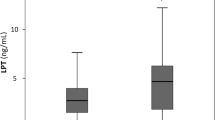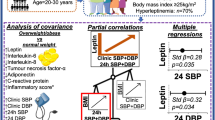Abstract
OBJECTIVE: To investigate whether intima-media thickness (IMT) of the common carotid artery (CCA), an early marker of asymptomatic atherosclerosis, is significantly and independently associated with plasma concentrations of leptin, an adipose tissue hormone that has recently been proposed as a cardiovascular risk factor in obese patients.
DESIGN: Cross-sectional sample of normal-weight and obese men and women.
SUBJECTS: One-hundred and twenty healthy subjects (52 men and 68 women), aged 18–45 y and with a wide range of BMI, were recruited for the study.
MEASUREMENTS: Fasting plasma leptin concentrations and the IMT of the CCA were measured in all subjects. Leptin concentrations were measured by radioimmunoassay and the IMT of the CCA was quantified by high resolution B-mode ultrasound imaging. Central fat (measured by waist circumference), smoking habits, blood pressure, insulin sensitivity (measured by the insulin tolerance test), and fasting plasma glucose, insulin and lipid pattern (cholesterol, HDL-cholesterol, triglycerides, LDL-cholesterol) were also measured.
RESULTS: IMT of the CCA was positively correlated with log leptin concentrations (P<0.005 in men and P<0.001 in women), body mass index (P<0.001 in men and women), waist circumference (P<0.001 in men and women), age (P<0.001 in men and P<0.05 in women), and negatively associated with insulin sensitivity in both sexes (P<0.05). IMT was also directly correlated with cholesterol (P<0.05), LDL-cholesterol (P<0.01) and systolic blood pressure in men (P<0.05), and with diastolic blood pressure levels in women (P<0.05). When a multiple linear regression model was used without body mass index (BMI), the correlation between leptin and IMT was maintained in both men (P<0.01) and women (P<0.005), independent of age, insulin sensitivity, smoking habits, systolic blood pressure, fasting glucose, triglycerides, cholesterol, LDL-cholesterol and HDL-cholesterol. By contrast, BMI-adjusted leptin concentrations were not significantly associated with IMT (Pc (partial correlation): 0.41 in men and 0.15 in women). Moreover, when BMI was entered into a multiple linear regression model without leptin, the correlation between BMI and IMT was maintained in both men (P<0.005) and women (P<0.01), independent of the same parameters.
CONCLUSION: Plasma leptin concentrations are independently associated with the IMT of the CCA, suggesting that the increase of adipose tissue mass (or leptin per se) may have an unfavourable influence on the development of atherosclerosis. However, the association between IMT and leptin seems to be dependent and/or confounded by the relationship between IMT and obesity.
This is a preview of subscription content, access via your institution
Access options
Subscribe to this journal
Receive 12 print issues and online access
$259.00 per year
only $21.58 per issue
Buy this article
- Purchase on Springer Link
- Instant access to full article PDF
Prices may be subject to local taxes which are calculated during checkout
Similar content being viewed by others
References
Crouse JR III, Craven TE, Hagaman AP, Bond MG . Associations of coronary disease with segment specific intimal-medial thickening of the extracranial carotid artery Circulation 1995 92: 1141–1147.
Pignoli P, Tremoli E, Poli A, Oreste P, Paoletti R . Intimal plus medial thickness of the arterial wall: a direct measurement with ultrasound imaging Circulation 1986 74: 1399–1406.
Craven TE, Ryu JE, Espeland MA, Kahl FR, McKinney WM, Toole JF, McMahan MR, Thomson CJ, Heiss G, Crouse JR III . Evaluation of the associations between carotid artery atherosclerosis and coronary artery stenosis: a case–control study Circulation 1990 82: 1230–1242.
Salonen JT, Salonen R . Ultrasonographically assessed carotid morphology and the risk of coronary heart disease Arterioscler Thromb 1991 11: 1245–1249.
Haapanen A, Koskenvuo M, Kaprio J, Kesaniemi YA, Heikkila K . Carotid arteriosclerosis in identical twins discordant for cigarette smoking Circulation 1989 80: 10–16.
Kuller L, Borhani N, Furberg C, Gardin J, Manolio T, O'Leary D, Psaty B, Robbins J . Prevalence of subclinical atrherosclerosis and cardiovascular disease and association with risk factors in the Cardiovascular Health Study Am J Epidemiol 1994 139: 1164–1179.
Yamamoto M, Egusa G, Yamakido M . Association of intraabdominal fat and carotid atherosclerosis in non-obese middle-aged men with normal glucose tolerance Int J Obes Relat Metab Disord 1997 21: 948–951.
Ciccone M, Maiorano A, De Pergola G, Minenna A, Giorgino R, Rizzon P . Microcirculatory damage of common carotid artery wall in obese and non obese subjects Clin Hemorheol Microcirc 2000 21: 365–374.
De Pergola G, Ciccone M, Pannacciulli N, Modugno M, Sciaraffia M, Minenna A, Rizzon P, Giorgino R . Lower insulin sensitivity as an independent risk factor for carotid wall thickening in normotensive, non-diabetic, non-smoking normal weight and obese premenopausal women Int J Obes Relat Metab Disord 2000 24: 825–829.
Bonora E, Tessari R, Micciolo R, Zenere M, Targher G, Padovani R, Falezza M, Muggeo M . Intimal-medial thickness of the carotid artery in nondiabetic and NIDDM Diabetes Care 1997 20: 627–631.
Kawamori R, Yamasaki Y, Matsushima H, Nishizawa H, Nao K, Hougaku H, Maeda H, Handa N, Matsumoto M, Kamada T . Prevalence of carotid atherosclerosis in diabetic patients Diabetes Care 1992 15: 1290–1294.
Ferrara LA, Mancini M, Celentario A, Galderisi M, Iannuzzi R, Marotta T, Gaeta I . Early changes of the arterial carotid wall in uncomplicated primary hypertension patients. Study by ultrasound high-resolution B-mode imaging Arterioscler Thromb 1994 14: 1290–1296.
Wendelhag I, Wiklund O, Wikstrand J . Atherosclerotic changes in the femoral and carotid arteries in familial hypercholesterolemia: ultrasonographic assessment of intima-media thickness and plaque occurrence Arterioscler Thromb 1993 13: 1404–1411.
Foger B, Luef G, Ritsch A, Schmidauer C, Doblinger A, Lechleitner M, Aichner F, Patsch JR . Relationship of high-density lipoprotein subfraction and cholesteryl ester transfer protein in plasma to carotid artery wall thickness J Mol Med 1995 73: 369–372.
Sharrett AR, Patsch W, Sorlie PD, Heiss G, Bond MG, Davis CE for the ARIC Investigators . Associations of lipoprotein cholesterols, apolipoprotein A-I and B, and triglycerides with carotid atherosclerosis and coronary heart disease Arterioscler Thromb 1994 14: 1098–1104.
Zhang Y, Proenca R, Maffei M, Barone M, Leopold L, Friedman JM . Positional cloning of the mouse obese gene and its human homologue Nature 1994 372: 25–32.
Lonnquist F, Arner P, Nordfors L, Schalling . Overexpression of the obese (ob) gene in adipose tissue of human obese subjects Nature Med 1995 1: 950–953.
Considine RV, Sinha MK, Heinman ML, Kriauciuciunas A, Stephens TW, Nyce MR . Serum immunoreactive-leptin concentrations in normal-weight and obese subjects New Engl J Med 1996 334: 292–295.
Vettor R, De Pergola G, Pagano C, Englaro P, Laudadio E, Giorgino F, Blum W, Giorgino R, Federspil G . Gender differences in serum leptin in obese people: relationship with testosterone, body fat distribution and insulin sensitivity Eur J Clin Invest 1997 27: 1016–1024.
Ebihara K, Ogawa Y, Isse N, Mori K, Tamura N, Masuzaki H, Ko Yura S, Hosoda K, Sagawa N, Nakao K . Identification of the human leptin 5′-flanking sequences involved in the trophoblast-specific transcription Biochem Biophys Res Commun 1997 241: 658–663.
Bado A, Levasseur S, Attoub S, Kermorgant S, Laigneau JP, Borto Moizo L, Lehy T, Guerre-Millo M, Le Marchand-Brustel Y, Lewin M . The stomach is a source of leptin Nature 1998 394: 790–793.
Leyva F, Goldland IF, Ghatei M, Proudler AJ, Aldis S, Walton C, Bloom S, Stevenson JC . Hyperleptinemia as a component of a metabolic syndrome of cardiovascular risk Arterioscler Thromb Vasc Biol 1998 18: 928–933.
Report of the Expert Committee on the Diagnosis and Classification of Diabetes Mellitus Diabetes Care 1997 20: 1183–1197.
Lemieux S, Prud'Homme D, Bouchard C, Tremblay A, Desprès JP . Sex difference in the relation of visceral adipose tissue to total body fatness Am J Clin Nutr 1993 58: 463–467.
De Mitrio V, De Pergola G, Vettor R, Marino R, Sciaraffia M, Pagano C, Scaraggi FA, Di Lorenzo L, Giorgino R . Plasma plasminogen activator inhibitor-1 (PAI-1) is associated with plasma leptin, irrespective of body mass index, body fat mass, and plasma insulin and metabolic parameters in premenopausal women Metabolism 1999 48: 960–964.
Soderberg S, Olsson T, Eliasson M, Johnson O, Ahrén B . Plasma leptin levels are associated with abnormal fibrinolysis in men and postmenopausal women J Intern Med 1999 245: 533–543.
Bouloumiè A, Drexler HC, Lafontan M, Busse R . Leptin, the product of ob gene, promotes angiogenesis Circulation Res 1998 83: 1059–1066.
Bouloumiè A, Marumo T, Lafontan M, Busse R . Leptin induces oxidative stress in human endothelial cells FASEB J 1999 13: 1231–1238.
Paolisso G, Tagliamonte MR, Galderisi M, Zito GA, Petrocelli A, Carella C, de Divitiis O, Varricchio M . Plasma leptin level is associated with myocardial wall thickness in hypertensive insulin-resistant men Hypertension 1999 34: 1047–1052.
Sodeberg S, Ahrén B, Stegmayr B, Johnson O, Wiklund PG, Weinehall L, Hallmans G, Olsson T . Leptin is a risk marker for first-ever hemorrhagic stroke in a population-based cohort Stroke 1999 30: 328–337.
Soderberg S, Ahrén B, Jansson JH, Johnson O, Hallmans G, Asplund K, Olsson T . J Intern Med 1999 246: 409–418.
Aizawa-Abe M, Ogawa Y, Masuzaki H, Ebihara K, Satoh N, Iwai H, Matsuoka N, Hayashi T, Hosoda K, Inoue G, Yoshimasa Y, Nakao K . Pathophysiological role of leptin in obesity-related hypertension J Clin Invest 2000 105: 1243–1252.
Author information
Authors and Affiliations
Corresponding author
Rights and permissions
About this article
Cite this article
Ciccone, M., Vettor, R., Pannacciulli, N. et al. Plasma leptin is independently associated with the intima-media thickness of the common carotid artery. Int J Obes 25, 805–810 (2001). https://doi.org/10.1038/sj.ijo.0801623
Received:
Revised:
Accepted:
Published:
Issue Date:
DOI: https://doi.org/10.1038/sj.ijo.0801623
Keywords
This article is cited by
-
Sex-specific associations between adipokine profiles and carotid-intima media thickness in the Cameron County Hispanic Cohort (CCHC)
Cardiovascular Diabetology (2023)
-
Cerebral hemodynamics in obesity: relationship with sex, age, and adipokines in a cohort-based study
GeroScience (2021)
-
Ischemic stroke and select adipose-derived and sex hormones: a review
Hormones (2018)
-
CD133+ cells are associated with ADIPOCYTOKINES and endothelial dysfunction in hemodialysis patients
BMC Nephrology (2017)
-
Differences between perivascular adipose tissue surrounding the heart and the internal mammary artery: possible role for the leptin-inflammation-fibrosis-hypoxia axis
Clinical Research in Cardiology (2016)



